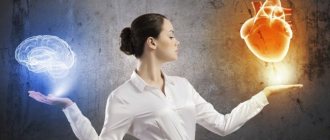Neuroticism refers to a personality trait that represents the degree to which a person experiences states of anxiety, threat, and insecurity. Each person is located in this personal dimension somewhere between the extreme poles - ideal emotional stability versus complete emotional chaos.
Note that neuroticism and neurosis should not be confused. Since the first is a personality trait and is inherent in healthy people, and the second is a functional neuropsychic disease that occurs under the influence of difficult experiences and mental stress.
Highly neurotic people tend to be labile (meaning they have a lot of fluid emotional reactions), restless, and tense. People with low levels of neuroticism, as a rule, are satisfied, self-confident and stable, subject to fewer physical and psychological problems, and less stress.
For many people, neuroticism accompanies frustration and dissatisfaction. Such individuals, as a rule, feel dissatisfaction with themselves and their lives. They are more likely to speak up about minor health problems and experience general discomfort in a variety of situations, and are more prone to negative emotions (eg, anxiety, depression, anger, guilt).
Empirical research shows that extremely high levels of neuroticism are associated with prolonged and pervasive suffering in both neurotic people and those close to them.
History of neuroticism
The concept of neuroticism dates back to the times of ancient Greece - to Hippocrates' model of the four main temperaments (choleric, sanguine, phlegmatic and melancholic, and the latter, by the way, is closest to neuroticism).
In modern psychometric personality research, neuroticism is identified as the first general factor and the variable with the widest range in explaining individual differences. For example, up to 50% of the variability in the manifestations of forms of mental disorders, such as depression, anxiety, and phobias, can be explained by the general aspect of neuroticism.
For this reason, neuroticism is almost always present in modern personality traits, although sometimes with slightly different formulations or designations (for example, ego stability, negative emotionality, etc.).
Hans Eysenck popularized the term "neuroticism" in the 1950s, including it as a key scale in his well-known personality model. Neuroticism also occupies a prominent place in the five-factor model of personality (Big Five), a technique designed to measure and diagnose personality (NEO).
Increasing, but still limited, evidence suggests that most of the basic personality traits (including neuroticism) identified in psychology are found across the board. Evidence of the importance of neuroticism in representatives of different countries, cultures, and people using different languages can be found in many large-scale cross-cultural studies.
Neuroticism and EEG
Neuroticism is associated with increased sensitivity to fear, anxiety, and stress. According to Eysenck's model, people with high levels of neuroticism are more responsible for negative emotions associated with the limbic system. Alpha oscillations (8–12 Hz) play a key role in awareness and attentional control. Frontal asymmetric alpha levels are associated with greater cortical activity in the hemisphere with lower alpha activity. Frontal EEG asymmetry mediates and mitigates motivational tendencies towards convergence/elimination of basic emotions. Let us remind the Blog reader that at the heart of the “arousal valence” model, the valence of emotions is more important than motivational tendencies. Relatively higher activity of the left frontal region is associated with the general motivational system of appetite or the activation of any forms of behavior. In contrast, relatively higher activity in the right frontal region is associated with the avoidance system.
EEG studies showed a pattern of higher activation in the right frontal lobe when observing stimuli or rest. For example, higher relative left frontal activity might be expected to be associated with greater self-rated happiness, and higher relative right frontal activity might be predicted in response to negatively valenced stimuli. Resting alpha power in frontal asymmetry predicts self-reported global negative affect in response to clips and predicts the difference between global positive and negative affect.
Although the valence of negative emotions is associated with right frontal activity and the valence of positive emotions is associated with left frontal activity, there is evidence that this association does not occur in individuals who are in a state of anger. Accordingly, the valence of facial anger is associated with left frontal activity. Modern researchers believe that frontal asymmetry reflects motivational tendencies rather than a valence pattern. It can be assumed that these models provide only a description of the frontal EEG asymmetry of emotional processing, but do not provide a specific mechanism for the frontal asymmetry.
According to Coan and Allen (2004), asymmetry can be classified into several categories. Frontal EEG asymmetry is examined as: (1) an individual difference associated with trait-like features; (2) individual differences that may predict state-related emotional changes and reactions; (3) individual differences associated with psychopathological risk factors such as anxiety and depression; and (4) the state change function in emotion by examining state-related changes in asymmetry. The first three categories of research apparently suggest that frontal asymmetry is related to personality traits, while the fourth suggests that state-related changes in EEG asymmetry can be induced and observed. Resting-state frontal EEG asymmetry reveals individual differences that can simplify or weaken emotional responses to many categories of stimuli. The authors suggested that frontal asymmetry could be explained as a mediator or moderator variable for predicting emotional reactions. In the third model, Coan et al. (2006) proposed a capability model. This model shows that different patterns of frontal EEG activity are influenced by situations and contexts, reflecting the ability to adapt to the situation, which depends on the activation of emotion regulation and the suppression of emotional responses when necessary. The capability model focuses on emotional issues during problem solving, and this model believes that measuring frontal asymmetry during problem solving is a stronger indicator than asymmetry at rest.
Grimshaw and Carmel (2014) developed a model of asymmetric inhibition (model four) based on electrophysiological, neurological, and clinical studies. This model proposes that frontal asymmetry reflects cognitive control based in the dorsolateral prefrontal cortex (dlPFC). The DlPFC plays a key role in executive functions including working memory, shifting, inhibition, updating, and the attention network. The model suggests that the left dlPFC is responsible for the suppression of negative distractors, while the right dlPFC is responsible for the suppression of positive distractors. Weaker activity in the left frontal region reflects less effective suppression of negative information associated with depression and anxiety. Weaker activity in the right frontal region reflects less effective suppression of positive information associated with addiction and low levels of self-regulation. Additionally, studies have shown that the dlPFC is a top-down process for the regulation of the amygdala (Sagliano et al., 2021). The dlPFC is associated with threat appraisals, including external (fear) and social (anger) threats. Although the dlPFC regulates the amygdala in threat processing, we hypothesize that frontal asymmetry may play a role in regulating external threat. Note that the frontoparietal network controls attention to threats.
Using MRI, Forbes et al. (2014) found an association between higher scores of neuroticism and focal damage to the left dorsolateral prefrontal cortex in patients with brain damage. There is ample evidence that neuroticism is associated with lateralization, which in turn is triggered by changes in frontal lobe activation. However, this relationship with hemispheric asymmetry has not been demonstrated across all components of neuroticism. This right-dominant asymmetry appears to be typical of anxiety and depression and is associated with passive avoidance. In contrast, volatility subfactor traits, including anger sensitivity and aggressiveness, which are implicated in active defense, are associated with higher left frontal asymmetry.
Some studies of normal populations have found no association between neuroticism and frontal asymmetry (Kline et al., 2002), whereas Gale et al. (2001) showed that decreased activity in the right hemisphere is associated with neuroticism.
The findings suggest that variability in EEG asymmetry may be associated with a tendency to oscillate between positive and negative emotional states. Alternatively, this change may be associated with a shift between anxious arousal and anxious apprehension.
Negative evaluations for fearful faces are thought to require greater alpha activity in the left frontal region. In other words, when the alpha band is activated in a given region during the eyes-closed state, cortical excitation decreases in that region. Data from a number of studies have shown that the left frontal level of excitation is lower than the right frontal region. Because several studies have shown that cortical arousal is associated with decreased alpha activity (Barry et al., 2007, 2009), it appears that decreased alpha activity in the right frontal region is associated with increased cortical arousal during the eyes-closed condition, which may be associated with fear valence and neuroticism. EEG asymmetries were characterized by higher activity on the left side for positive emotions and higher activity on the right side for negative emotions.
Manifestations of extreme neuroticism
People with high levels of neuroticism are the owners of defensive pessimism. They perceive the world around them as unsafe and use radically different strategies to cope with anxiety (compared to people with low levels of neuroticism). They are vigilant about potential harm occurring in their relationships. The surrounding area is constantly checked to identify possible complications. They may at times refuse to perceive reality in favor of developing protective behavior when danger is detected.
Highly neurotic individuals, as a rule, do not cope well with solving problems. Because of their avoidance tendencies, they have little repertoire of behavioral alternatives or options for meeting the demands of reality. They are more likely to engage in mental role-play, rumination, and fantasy rather than engage in constructive problem-solving behavior.
However, despite this, they are the owners of a rich inner world. They are very introspective and prone to deep analysis of their own thoughts and feelings. They devote a large amount of energy to searching for the true nature of their inner experiences. Successful artists, directors, and actors are often neurotic individuals who have developed creative mechanisms through which they exploit their intimate, fantastic, and living worlds.
Although high neuroticism is associated with a low sense of well-being, high levels of neuroticism are not always interpreted as an unfavorable characteristic. Neurotic behavior may be important for survival by facilitating safety by inhibiting risky behavior.
Such people tend to have a high sense of anticipation of danger, which directs them to pay closer attention to unforeseen circumstances associated with possible negativity.
In addition, subjective discomfort and anxiety regarding violations of social norms are greater in a neurotic individual than in others. Thus, a neurotic person is less likely to engage in antisocial activities. As an example, adolescents with extremely low levels of neuroticism have a higher predisposition to crime in adulthood and experience low levels of discomfort with violating social rules of behavior.
Neurotic people, who are strongly focused on their own inner experiences, are also very attentive to physical discomfort. Their actions regarding maintaining health (visiting the gym, consulting with a doctor, etc.) are observed much more often than in people with lower levels of neuroticism. Although health complaints are very regular, their objectively assessed health is by no means worse than that of those with a low level of neuroticism. And even on the contrary - the general state of health is often better.
I'm neurotic - but that's ok
It is customary in society to label any more or less emotional person who is inclined to deeply experience life’s ups and downs as “neurotic.” However, science says that such people do not necessarily need to make an appointment with a psychologist for their “neuroticism.” Simple ways of self-regulation have long been invented for them.
What is a neurotic personality?
Neurotic personality - from the point of view of psychiatry, normal people who are more prone to depression, anxiety, blues and emotional instability. We can say that neurotics prefer to see the dark side of life and not trust people.
Brief test for neuroticism (neuroticism):
- I get irritated easily.
- I get stressed easily.
- I get upset easily.
- I have frequent mood swings.
- I often worry (what if something unpleasant happens).
- I'm more anxious than most people.
- Most of the time I am tense.
- I am often in a sad mood.
We give ourselves 1 if we “completely disagree with the statement” and 5 if we “completely agree”, other points accordingly. If you scored a total of more than 20, it means you are prone to neuroticism.
How does a neurotic's brain work?
Modern science allows us, to some extent, to get into a person’s head and understand why he behaves in one way or another. Half a century ago, Hans Eysenck determined that neurotics have a more reactive sympathetic nervous system and increased activity of the limbic system of the brain.
Later, functional MRI studies of neurotic people confirmed Eysenck's ideas, showing that the reactions of the tonsils of the brain of these people reliably exceeded the reactions of emotionally stable people. What causes reasonable fear in ordinary people, results in panic in neurotics.
Dr. A. Perkins (2015) published an article from which it follows that neurotics simply think too much and are characterized by so-called “self-generated thoughts” (SGM), i.e. thoughts that arise without an external stimulus. The presence of SGM explains why a neurotic person can experience fears even without the presence of an external threat, and also be in a bad mood when everything seems to be fine in his life.
By the way, it is not at all necessary to use sophisticated technology in order to find out whether a patient is really neurotic. The usual electrical conductivity of the skin, which is used in a lie detector, reliably identifies neurotic people. In neurotic people, skin conductance during stressful situations is sharply increased.
Whose fault is it that you are neurotic?
Most likely, genes are to blame. Dr Daniel Smith (University of Glasgow) identified a possible neuroticism gene, CRHR1, which is also responsible for the production of the stress hormone cortisol. In addition, neurotics have problems with another gene - GR1K3, on which the metabolism of glutamic acid in the brain depends, which is partly the biochemical basis of depressive states. The last gene can be called the “sinister gene”, since it is especially active in suicides.











